OLDSMOBILE SILHOUETTE 1993 Owners Manual
Manufacturer: OLDSMOBILE, Model Year: 1993, Model line: SILHOUETTE, Model: OLDSMOBILE SILHOUETTE 1993Pages: 323, PDF Size: 17.13 MB
Page 201 of 323
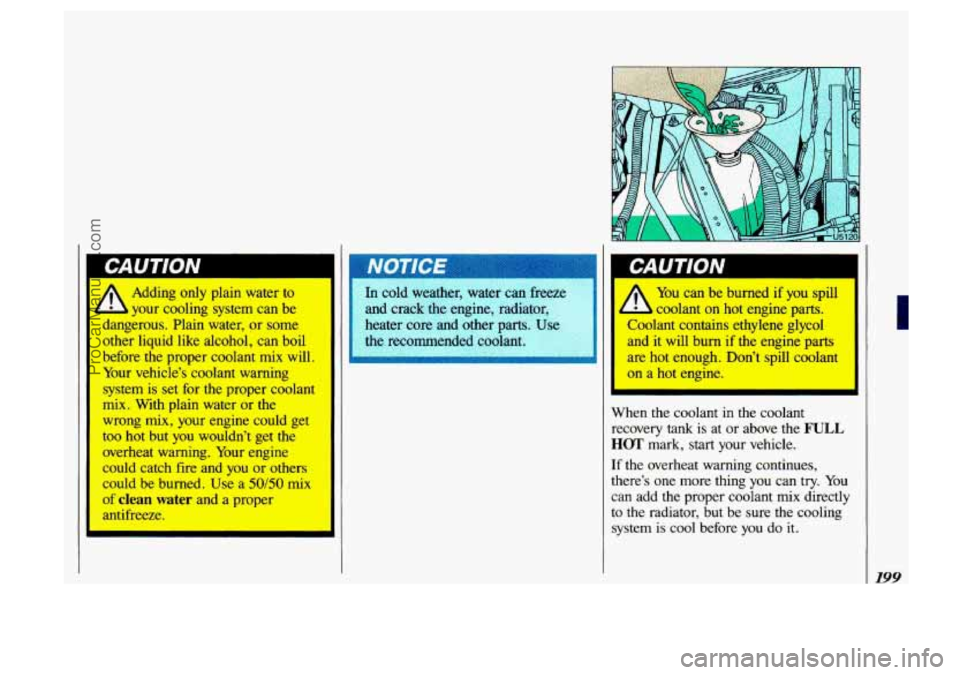
A
Adding only plain water to
your cooling system can be
dangerous. Plain water, or some
other liquid like alcohol, can boil
before the proper coolant mix will.
Your vehicle’s coolant warning
system is set for the proper coolant
mix. With plain water or the
wrong
mix, your engine could get
too hot but
you wouldn’t get the
overheat warning. Your engine
could catch fire and you or others
could be burned. Use a
50/50 mix
of clean water and a proper
antifreeze.
I
In cold- weatl , w r can .
and crack the engine, radial
heater core
and other parts. ‘,A
You can be burned if you spill
coolant on hot engine parts.
Coolant contains ethylene glycol
and it will burn
if the engine parts
are hot enough. Don’t spill coolant
on a hot engine.
I
When the coolant in the coolant
recovery
tank is at or above the FULL
HOT mark, start your vehicle.
If the overheat warning continues,
there’s one more thing you can try. You
can add the proper coolant
mix directly
to the radiator, but be sure the cooling
system is cool before
you do it.
199
ProCarManuals.com
Page 202 of 323
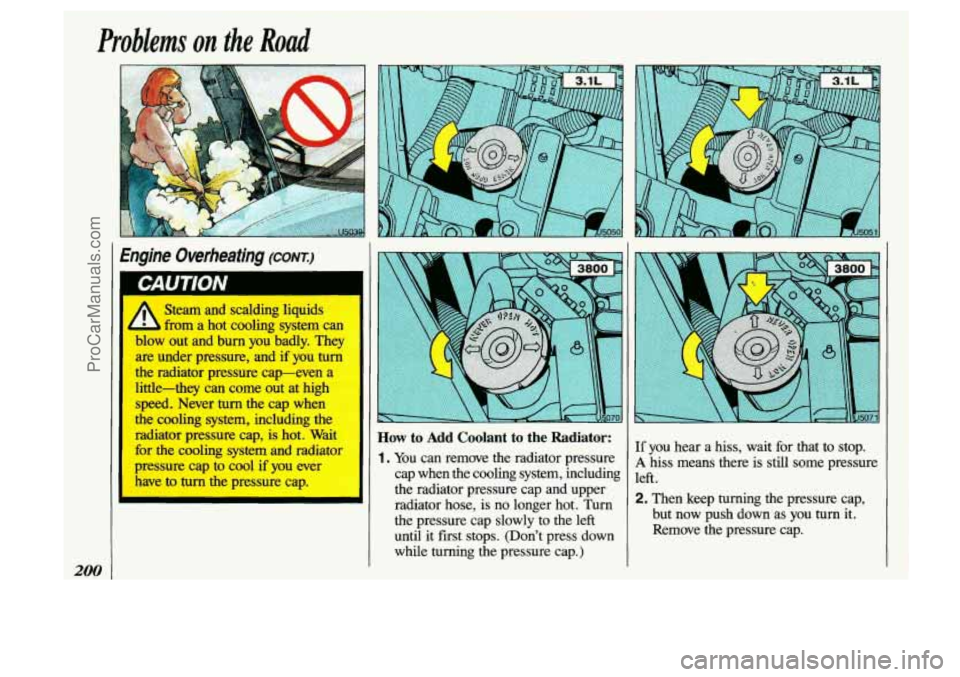
Problems on the Road
Engine Overheating (CONX)
I A Steam and scalding liquids I
I from a hot cooling system can
blow out and bum you badly. They
I
are under pressure, and if you turn
the radiator pressure cap-even a
little-they can come out at high
speed. Never
turn the cap when
the cooling system, including the
radiator pressure cap, is hot Wait
for the cooling system and radiator
pressure cap to cool if you ever
have to turn the pressure cap.
~ I Vow to Add Coolant to the Radiator:
I. You can remove the radiator pressure
cap when the cooling system, including
the radiator pressure cap and upper radiator hose, is no longer hot.
Turn
the pressure cap slowly to the left
until it first stops. (Don’t press down
while turning the pressure cap.)
If you hear a hiss, wait for that to stop.
A hiss means there is still some pressure
left.
2. Then keep turning the pressure cap,
but now push down as you turn it.
Remove the pressure cap.
~ 200
ProCarManuals.com
Page 203 of 323
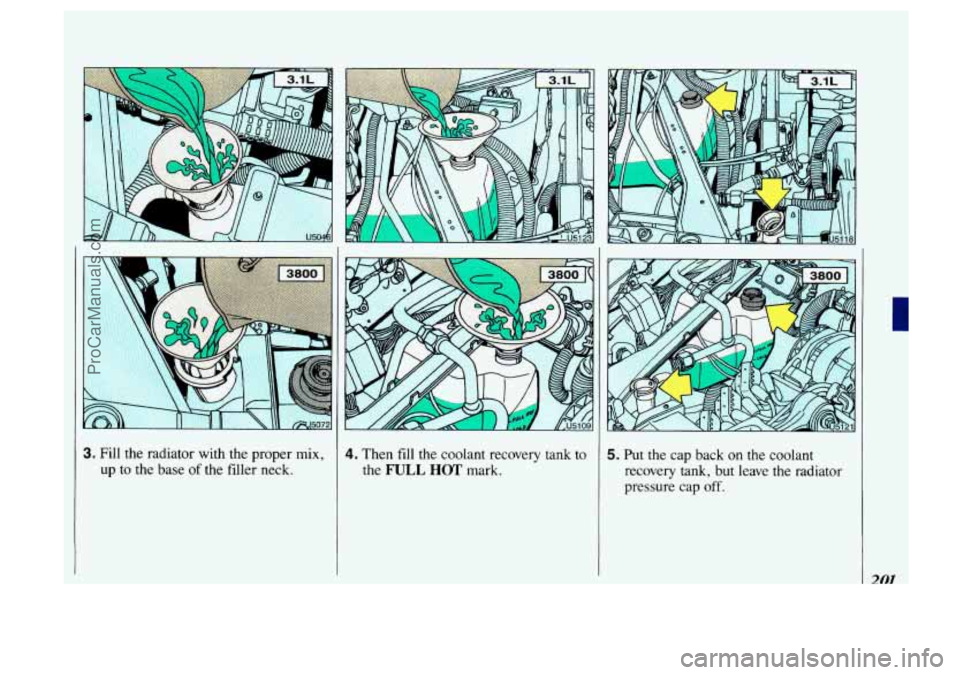
3. Fill the radiator with the proper mix,
up
to the base of the filler neck.
4. Then fill the coolant recovery tank to
the
FULL HOT mark.
5. Put the cap back on the coolant
recovery tank, but leave
the radiator
pressure cap
off.
201
ProCarManuals.com
Page 204 of 323
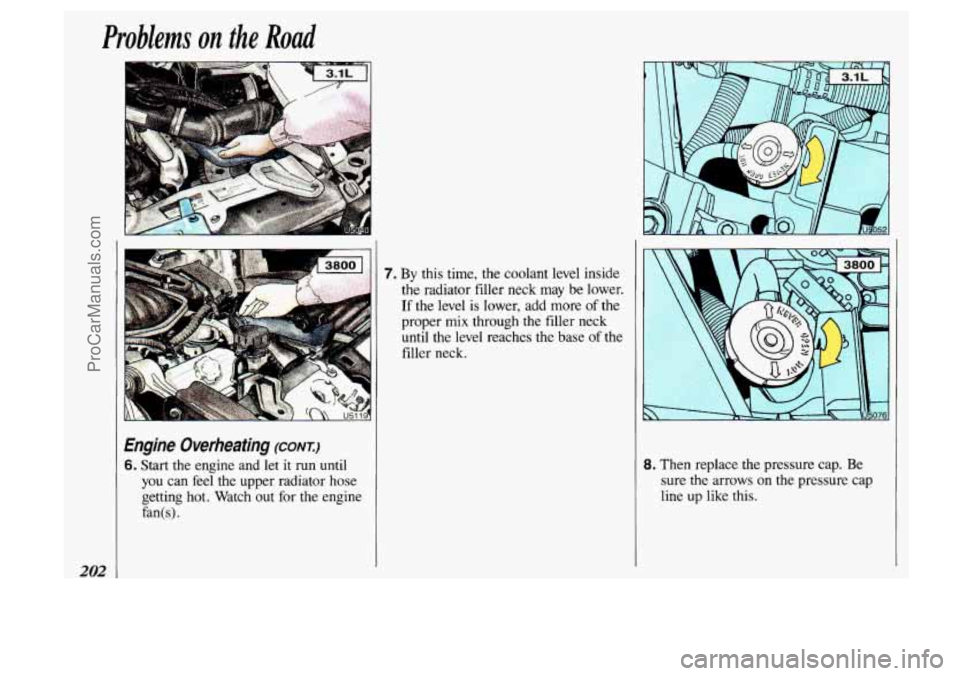
Problems on the Road
202
P
Engine Overheating (CONI)
6. Start the engine and let it run until
you can feel the upper radiator hose
getting
hot. Watch out for the engine
fan(
s) .
7. By this time, the coolant level inside
the radiator filler neck may be lower.
If
the level is lower, add more of the
proper
mix through the filler neck
until the level reaches the base
of the
filler neck.
8. Then replace the pressure cap. Be
sure the arrows
on the pressure cap
line up like this.
ProCarManuals.com
Page 205 of 323
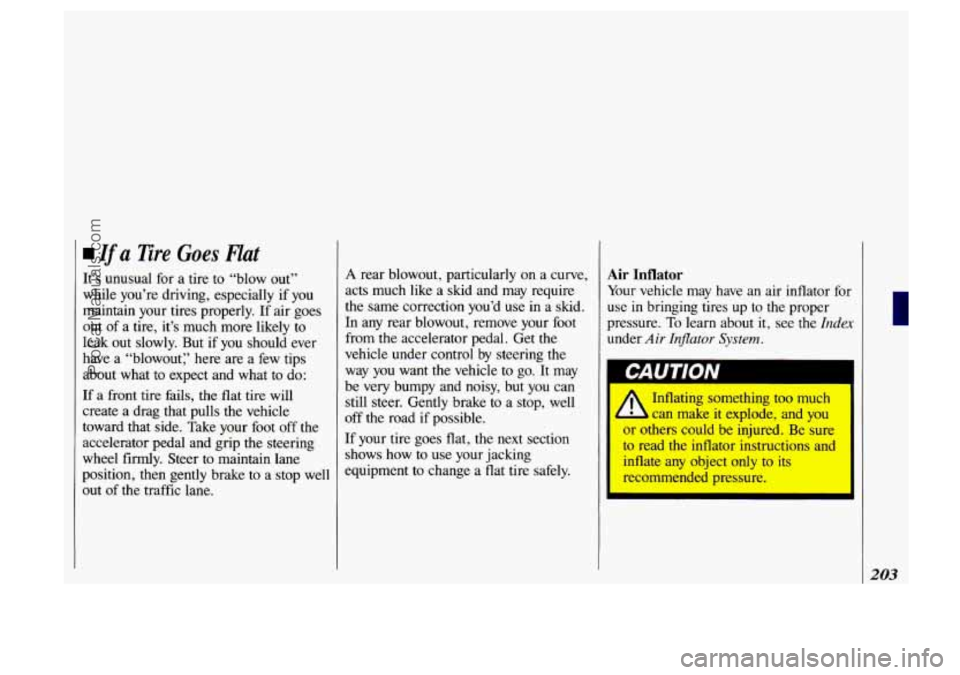
Ifa Tire Goes Hat
It’s unusual for a tire to “blow out”
while you’re driving, especially if
you
maintain your tires properly. If air goes
out of a tire, it’s much more likely to
leak out slowly. But if you should ever
have a “blowout:’ here are a few tips
about what
to expect and what to do:
If a front tire
fails, the flat tire will
create a drag that pulls
the vehicle
toward that side. Take your foot off the
accelerator pedal and grip the steering
wheel
firmly. Steer to maintain lane
position, then gently brake to a stop well
out of the traffic lane.
A rear blowout, particularly on a curve,
acts much like a skid and may require
the same correction you’d use in a skid.
In any rear blowout, remove your foot
from the accelerator pedal. Get
the
vehicle under control by steering the
way you want the vehicle to go.
It may
be very bumpy and noisy, but you can still steer. Gently brake to a stop, well
off the road if possible.
If your tire goes flat, the next section
shows how
to use your jacking
equipment to change a flat tire safely.
Air Inflator
Your vehicle may have an air inflator for
use
in bringing tires up to the proper
pressure.
To learn about it, see the Index
under Air Inflator System.
Inflating something too much
can make it explode, and
you
or others could be injured. Be sure
to read the inflator instructions and
inflate any object only to
its
recommended pressure.
I
203
ProCarManuals.com
Page 206 of 323
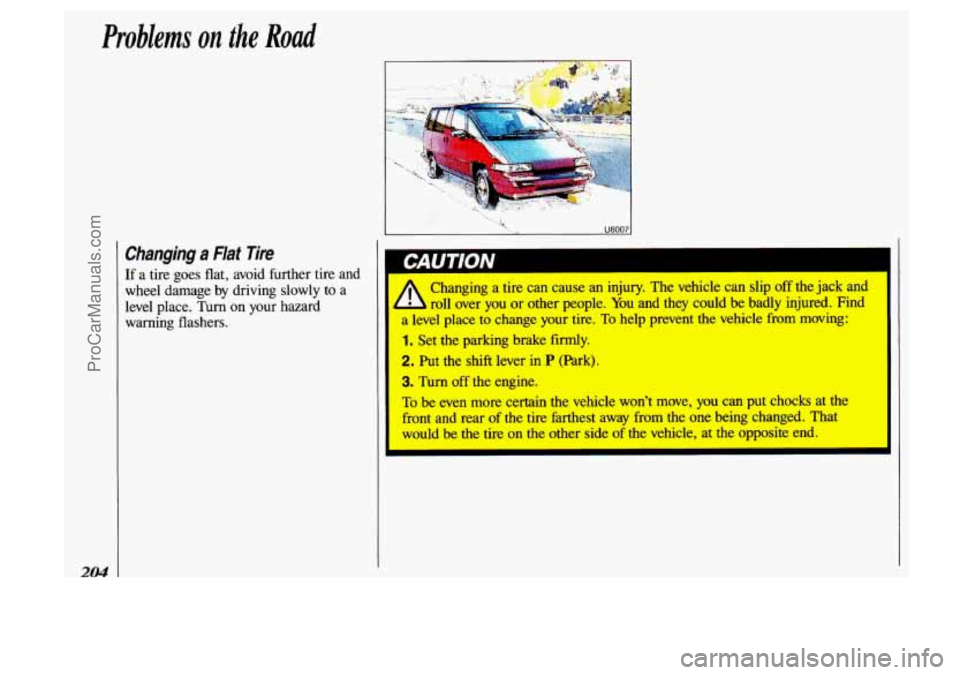
Problems on the Road
204
Changing a Flat Tire
If a tire goes flat, avoid further tire and
wheel damage by driving slowly
to a
level place.
Turn on your hazard
warning flashers.
I , c.
k., U6007
I
ProCarManuals.com
Page 207 of 323
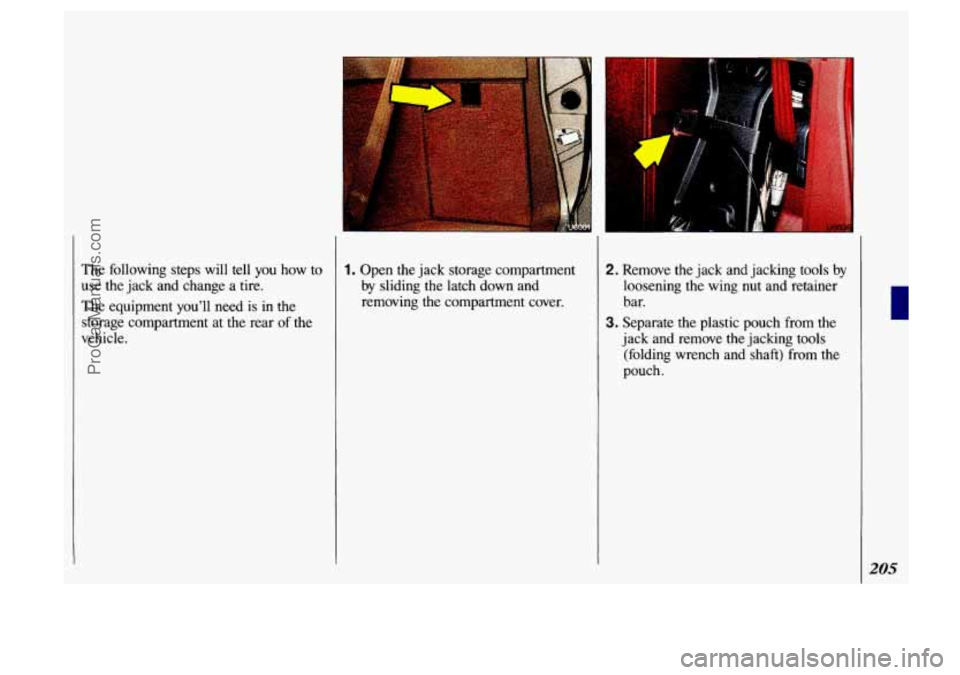
The following steps will tell you how to
use the jack and change a tire.
The equipment you’ll need is in the
storage compartment at the rear of the
vehicle. 1. Open the jack storage compartment
by sliding the latch down and
removing the compartment cover.
L
2. Remove the jack and jacking tools by
loosening the wing
nut and retainer
bar.
3. Separate the plastic pouch from the
jack and remove the jacking tools
(folding wrench and shaft) from the
pouch.
ProCarManuals.com
Page 208 of 323
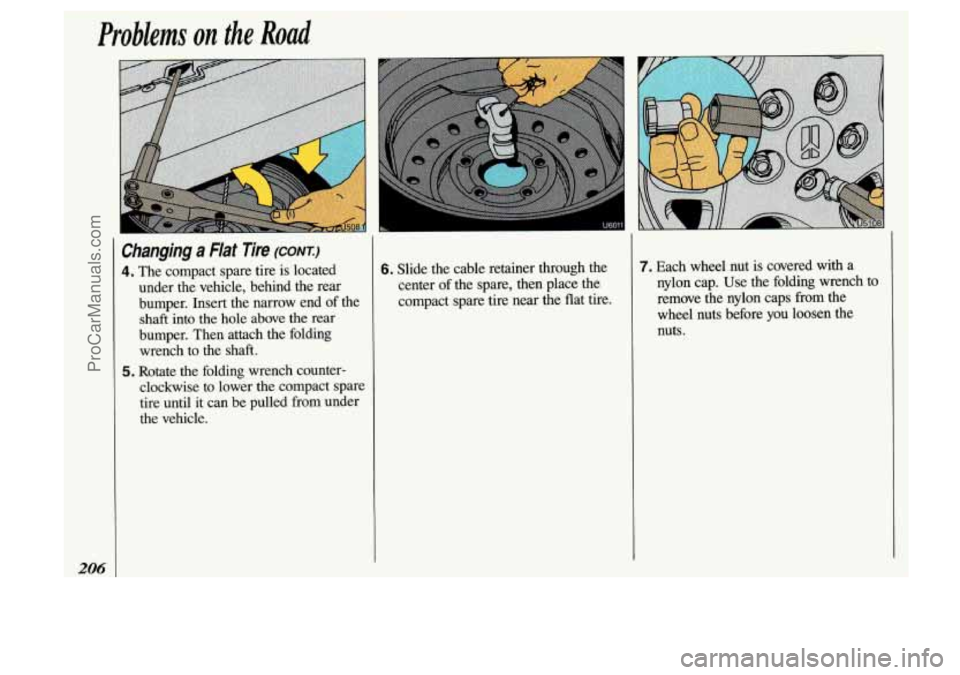
Problems on the Road
206
Changing a Elat Tire (corn)
4. The compact spare tire is located
under the vehicle, behind the rear
bumper. Insert the narrow end
of the
shaft into
the hole above the rear
bumper. Then attach the folding
wrench to the shaft.
5. Rotate the folding wrench counter-
clockwise to lower the compact spare
tire until it can be pulled from under
the vehicle.
6. Slide the cable retainer through the center
of the spare, then place the
compact spare tire near the flat tire.
7. Each wheel nut is covered with a
nylon cap. Use the folding wrench to
remove the nylon caps from the
wheel
nuts before you loosen the
nuts.
ProCarManuals.com
Page 209 of 323
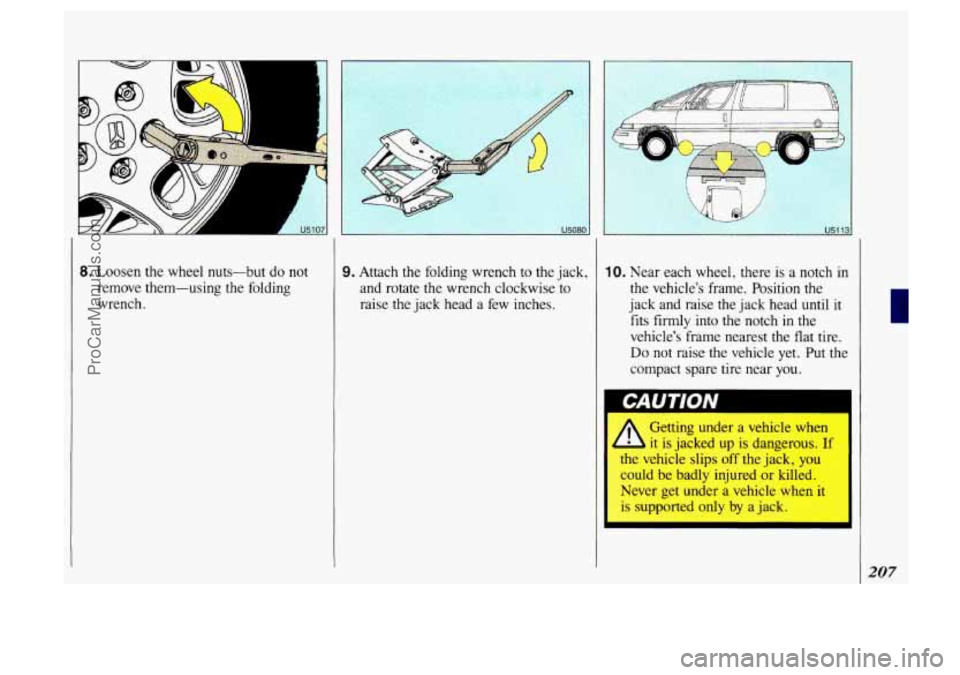
8. Loosen the wheel nuts-but do not
remove them-using the folding
wrench. 9. Attach the folding wrench to the jack,
and rotate the wrench clockwise to
raise the jack head a few inches. 10. Near each wheel, there is a notch in
the vehicle's frame. Position the
jack and raise the jack head until
it
fits firmly into the notch in the
vehicle's frame nearest the flat tire.
Do not raise the vehicle yet. Put the
compact spare tire near you.
A
Getting under a vehicle when
it is jacked up is dangerous. If
the vehicle slips off the jack, you
could be badly injured or killed.
Never get under a vehicle when
it
is supported only by a jack.
207
ProCarManuals.com
Page 210 of 323
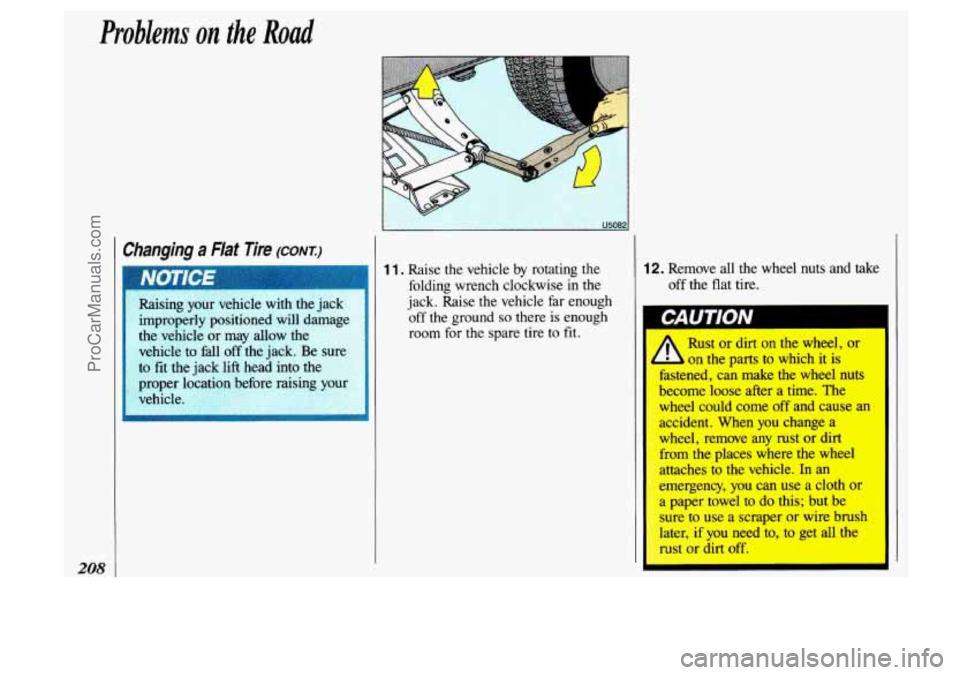
Problems on the Road
I Changing a Flat Tire (conm)
208
YO' I
1 1. Raise the vehicle by rotating the
folding wrench clockwise
in the
jack. Raise the vehicle far enough
off
the ground so there is enough
room for the spare tire to
fit.
12. Remove all the wheel nuts and take
off the flat tire.
ProCarManuals.com